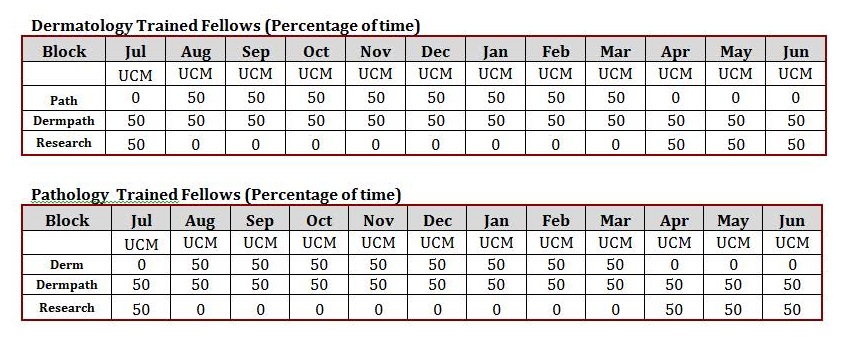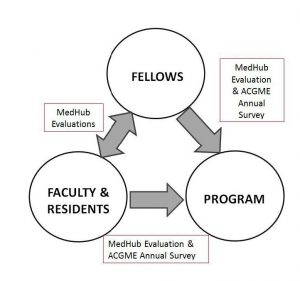| Q U I C K L I N K S
~*~ Other Resources |
Goals & Objectives | Curriculum | Clinical Experiences | Research | Well-Being Accredited by the ACGME in 1977, the advanced program has two accredited fellowship positions – PGY5. One position is funded by the institution and the second position requires the fellow to provide independent funding. The completion of residency training is required which can be a preliminary year plus three years of dermatology residency or 3-4 years of pathology residency. Successful fellows are eligible at the conclusion of their training for certification by the American Board of Dermatology. The fellowship follows the recruiting guidelines provided by the American Society of Dermatopathology which is detailed on a separate page. The training program is located in the Hyde Park neighborhood of south Chicago at the University of Chicago Medical Center. Goals & Objectives The overall goal of this subspecialty program is to train expert, subspecialist consultants in the microscopic diagnosis of diseases of the skin and mucosae. We expect that all our Fellows will devote a large part of their careers to dermatopathology, and will apply their knowledge compassionately and ethically. Furthermore we hope that, in return for the privilege of receiving an advanced medical education, they will contribute through their work to the scientific foundations of our noble profession. On a more down-to-earth level, expertise in dermatopathology is gained by mastering several key elements. To that end, dermatopathology Fellows are expected to achieve the following objectives:
Curriculum Surgical Pathology Experience for Dermatology Trained Fellows The Fellows are expected, by the completion of the eight-month training period, to have accomplished or achieved the acquisition of a knowledge and skill base that will support the following goals:
Dermatology Clinic Experience for Pathology-Trained Fellows The Fellows are expected, by the completion of the eight-month training period, to have accomplished or achieved the acquisition of a knowledge and skill base that will support the following goals:
This combination is the foundation for developing educational goals and objectives and the evaluation tools to measure the progress of training for Fellows. Each milestone is measured in five levels of complexity from basic knowledge through advanced knowledge for the level of the Fellow’s training.
This is a comprehensive, 360° process that includes fellows and residents, faculty, clinical and administrative staff and program. On the fellows level, the ACGME compentencies and milestones are the basis for determining progress in training. In addition to evaluations from faculty and staff, the fellows also receive evaluations from dermatology and pathology residents. All evaluations are reviewed semi-annually by the Clinical Competency Committee (CCC) in accordance with the requirements of the ACGME. Evaluations completed by the felows for faculty members are included in the residents’ aggregated, anonymous report which is reviewed by the Section Chief and Fellowship Director. Both fellows and faculty participate in the program’s evaluation by completing the institutional GME and ACGME annual surveys. Information from these reports is used by the Program Evaluation Committee (PEC) to institute program improvements and complete the annual Annual Program Evaluation (APE) for the institution and the ACGME Accreditation Data System (ADS) report.
Clinical Experiences The primary training location is the Dermatology Outpatient Clinic at UCM Duchossois Center for Advanced Medicine (DCAM) – Hyde Park where we provide “excellent skin care from head to toe.” Just like our training program is a close collaboration between the two disciplines, on a clinical level dermatology and pathology coordinate the preparation and interpretation of clinical specimens to arrive at a diagnosis for clinical care. Scholarship by Fellows Fellows are strongly encouraged to contribute to medical knowledge through scholarly activity, presentations, and publications. This can take the form of original research, case reports, chapters, reviews, and oral and poster presentations at medical conferences. Fellow are strongly encouraged to pursue research projects and to submit abstracts for presentation at professional meetings. Fellows are supported in their scholarly activities with an annual education fund which can be used to pay for related expenses such as conference registration and travel and additional study materials. The program also provides supplemental funding for ASDP registration and presentation expenses. Fellows frequently participate in these meetings:
Publication Examples
Well-Being As part of the supervisory responsibilities of the PD and faculty, monitoring the well-being of the Fellows is essential. Well-being is a multi-faceted concept that can include physical and mental health all with the purpose of maximizing the quality of the Fellows’ training experience. The foundation of the Dermatopathology Fellowship Program is to foster a safe environment for the fellows so that they can discuss any isssues directly with the PD or faculty. Also, the faculty and clinical staff should be comfortable bringing concerns to the PD. A Fellow has the opportunity to discuss issues or concerns one-on-one with the PD by scheduling an indivual appointment or at a scheduled Milestones review. The Section of Dermatology supports the program’s efforts by providing team building workshops such as the Hearing One Another provided by the UC Center for Identity & Inclusion. |


